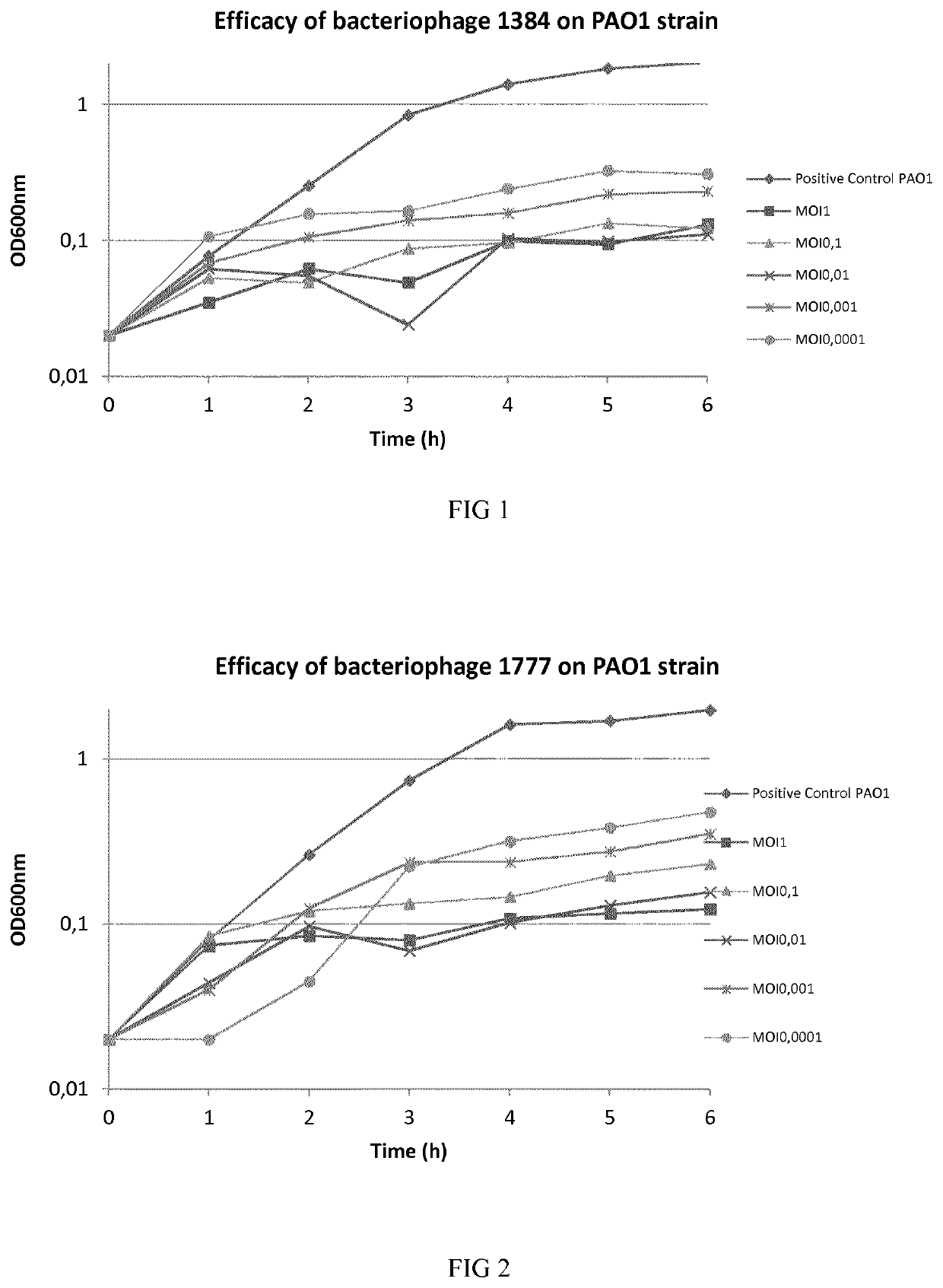Phage therapy
a phage and bacterial infection technology, applied in the field of phage therapy, can solve the problems of inconvenient use, high controversy, inconsistent results, etc., and achieve the effect of potent antibacterial
- Summary
- Abstract
- Description
- Claims
- Application Information
AI Technical Summary
Benefits of technology
Problems solved by technology
Method used
Image
Examples
example 1
hage Isolation
[0119]Bacteriophages were isolated from environmental samples. Multi Drug Resistant (MDR) P. aeruginosa bacteria were used for isolating and enriching each virulent bacteriophage from environmental water. More particularly, environmental samples and overnight culture of bacteria in Luria Bertani (LB) were mixed and incubated at 37° C. for 24 h with shaking to enrich specific bacteriophages. At the end of incubation, drops of chloroform were added to the culture. The culture was spun down at 11,000 g for 5 minutes to remove bacterial cells and debris. The supernatant was subjected to 0.2 μm filter to remove the residual bacterial cells. The enriched phage solution was plated on LB agar medium with P. aeruginosa embedded. Plaques formed on the plates after 24 h incubation at 37° C. Single plaque was picked out for subsequent phage purification and amplification. The phage was then stored at 4° C. in a suspension in LB broth or physiological saline.
[0120]The titer of phag...
example 2
hage Host Characteristics and Kinetics
[0123]One-step growth experiments were carried out according to the previous descriptions to determine first the productive lytic time, adsorption rate, and then the phage burst size. To determine the adsorption rate samples were taken at different time intervals to analyze the free phage particles in the solutions. For productive time and phage burst size determination, P. aeruginosa bacteria were mixed with phages solutions and phages were allowed to adsorb for 15 min. The mixture was subjected to centrifugation immediately at 5000 rpm for 10 min to remove free phage particles. The pellet was resuspended in 5 fresh LB medium and the culture was continuously incubated at 37° C. Samples were taken at 5 min intervals and phage titer was determined. These results permitted to calculate the number of phages produced per bacteria (burst size), the productive time and the productive lytic effect (PLE), as shown in table 3 below.
[0124]
TABLE 3Productiv...
example 3
on of Bacteriophages
[0126]The following cocktail compositions are constituted, each comprising between 109 and 1011 pfu of each bacteriophage:
[0127]
TABLE 4CocktailPhagesIP1797 + P1902IIP1797 + P1800 + P1384IIIP1777 + P1797 + P1940 + P1384IVP1777 + P1792 + P1797 + P1800 + P1384VP1777 + P1792 + P1797 + P1800 + P1902 + P1384VIP1777 + P1792 + P1797 + P1800 + P1902 + P1940 + P1384VIIP1792 + P1384VIIIP1797 + P1384
PUM
| Property | Measurement | Unit |
|---|---|---|
| composition | aaaaa | aaaaa |
| morphology | aaaaa | aaaaa |
| resistance | aaaaa | aaaaa |
Abstract
Description
Claims
Application Information
 Login to View More
Login to View More - Generate Ideas
- Intellectual Property
- Life Sciences
- Materials
- Tech Scout
- Unparalleled Data Quality
- Higher Quality Content
- 60% Fewer Hallucinations
Browse by: Latest US Patents, China's latest patents, Technical Efficacy Thesaurus, Application Domain, Technology Topic, Popular Technical Reports.
© 2025 PatSnap. All rights reserved.Legal|Privacy policy|Modern Slavery Act Transparency Statement|Sitemap|About US| Contact US: help@patsnap.com



